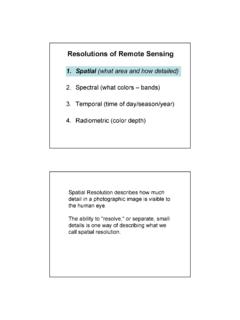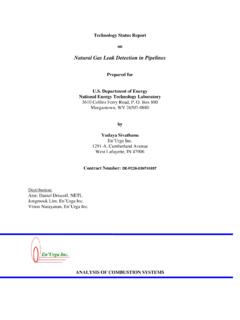Transcription of Common Landsat Band Combinations - Middlebury College
1 Practical Guides to remote sensing - American Museum of Natural History Common Landsat band Combinations Here are some Common RGB band Combinations (color composites): 3,2,1 RGB This color composite is as close to true color that we can get with a Landsat ETM image. It is also useful for studying aquatic habitats. The downside of this set of bands is that they tend to produce a hazy image. 4,3,2, RGB This has similar qualities to the image with bands 3,2,1 however, since this includes the near infrared channel ( band 4) land water boundaries are clearer and different types of vegetation are more apparent.
2 This was a popular band combination for Landsat MSS data since that did not have a mid- infrared band . 4,5,3 RGB This is crisper than the previous two images because the two shortest wavelength bands (bands 1 and 2) are not included. Different vegetation types can be more clearly defined and the land/water interface is very clear. Variations in moisture content are evident with this set of bands. This is probably the most Common band combination for Landsat imagery. 7,4,2 RGB This has similar properties to the 4,5,3 band combination with the biggest difference being that vegetation is green.
3 This is the band combination that was selected for the global Landsat mosaic created for NASA. Practical Guides to remote sensing - American Museum of Natural History Landsat Spectral band Information Landsat images are composed of seven different bands, each representing a different portion of the electromagnetic spectrum. In order to work with Landsat band Combinations (RGB composites of three bands) first we must understand the specifications of each band . Here is a list of the bands with some information about them. band 1 ( m, blue-green) Since this short wavelength of light penetrates better than the other bands it is often the band of choice for aquatic ecosystems.
4 It is used to monitor sediment in water, mapping coral reefs, and water depth. Unfortunately this is the noisiest of the Landsat bands since short wavelength blue light is scattered more than the other bands. For this reason it is rarely used for "pretty picture" type images. band 2 ( m, green) This has similar qualities to band 1 but not as extreme. The band was selected because it matches the wavelength for the green we see when looking at vegetation. band 3 ( m, red) Since vegetation absorbs nearly all red light (it is sometimes called the chlorophyll absorption band ) this band can be useful for distinguishing between vegetation and soil and in monitoring vegetation health.
5 band 4 ( m, near infrared ) Since water absorbs nearly all light at this wavelength water bodies appear very dark. This contrasts with bright reflectance for soil and vegetation so it is a good band for defining the water/land interface. band 5 ( m, mid- infrared ) This band is very sensitive to moisture and is therefore used to monitor vegetation and soil moisture. It is also good at differentiating between clouds and snow. band 6 ( m, thermal infrared ) This is a thermal band , which means it can be used to measure surface temperature. This is primarily used for geological applications but it is sometime used to measure plant heat stress.
6 This is also used to differentiate clouds from bright soils since clouds tend to be very cold. One other difference between this band and the other multispectral ETM bands is that the resolution is half of the other bands (60 m instead of 30 m). band 7 ( m mid- infrared ) This band is also used for vegetation moisture although generally band 5 is preferred for that application, as well as for soil and geology mapping. Practical Guides to remote sensing - American Museum of Natural History







